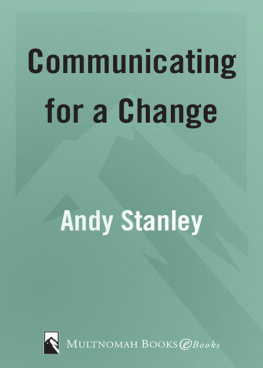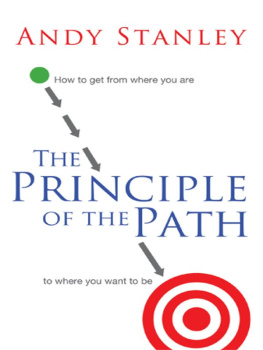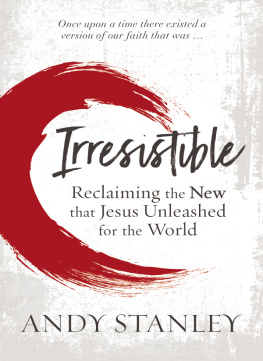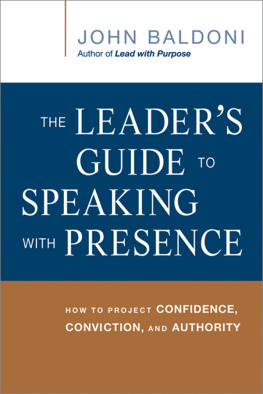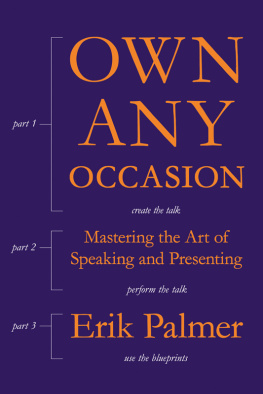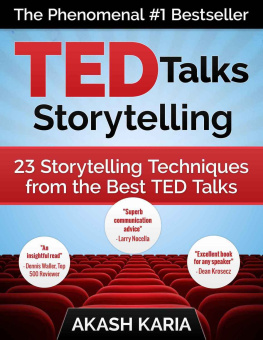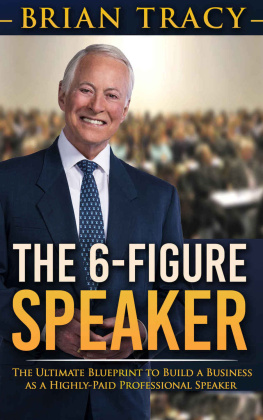Most Christians can remember who was speaking the first time they heard the Scriptures taught in a way that captured their attention and created a hunger for more. For Lane and me, it was the same person. My dad. This book would not be possible apart from his influence. We would also like to thank our wives, Traci and Sandra. Specifically, we are grateful for their words of encouragement following messages where it might have been difficult to find anything encouraging to say. As always, we are grateful to Multnomah Publishers for their partnership and commitment to the local church. To our editors, Brian Thomasson and David Webb, thanks for your insight and patience.
INTRODUCTION
by Andy Stanley
I never felt called to preach. I just volunteered. I wanted to feel called. But it just never happened for me. Several of my friends felt called while we were in high school. They went forward during a Sunday night service and shared it with the congregation. Everybody clapped. Some of them are still in ministry. I think one of em is in jail.
One afternoon I was driving somewhere with my dad. After one of those long moments of silence that fathers and sons have when driving together, I spoke up and said, Dad, does a person have to be called into ministry or can they just volunteer?
He thought for a moment. Well, I guess its okay to volunteer.
Good, I said. I would like to volunteer. So I did. In fact, it was two volunteer environments that shaped me as a communicator.
During my sophomore year of college our youth pastor, Sid Hopkins, asked me if I would help him lead our Wednesday night student Bible study. That was a really strange request since we didnt even have a Wednesday night Bible study. Upon further investigation I discovered that he wanted me to start a study for our students. I had never led or taught anything in my life. I was a whopping two years older than some of the students I would be teaching. But I agreed to give it a try.
The good thing about being so young was that I knew what wouldnt work. Preaching wouldnt work. Teaching for twenty or thirty minutes wouldnt work. A verse by verse Bible study wouldnt work. Telling a bunch of stories and tacking on a point wouldnt work. So I decided to err on the side of simplicity. Nobody told me how long our Bible study was supposed to last, so I didnt feel compelled to fill up a lot of time. I had been given a blank page.
On week one about twenty students showed up. I passed out three by five cards with one verse printed on one side and a question printed on the other side. The verse for that first week was John 17:4.
I GLORIFIED YOU ON THE EARTH, HAVING ACCOMPLISHED THE WORK WHICH YOU HAVE GIVEN ME TO DO (NASB).
We talked about what it meant to glorify something. I explained that glorifying the Father was Christs chief purpose for coming and that it should be ours as well. Then I had them turn the card over and spend thirty seconds thinking about an answer to the following question: What can I do this week to glorify God in my world?
Then I closed in prayer. The whole thing took about fifteen minutes. One point. One question. One application. Everybody stayed awake. Everybody was engaged. Everybody could remember what the lesson was about. Sid was a bit concerned about the brevity. But the next week the crowd grew. And it kept growing. Every week I handed out a card with a verse and a question. No music. No pizza. We didnt even have a PA system. That was my first experience as a communicator. It taught me a valuable lesson that would be reiterated a few years later.
In 1981 I moved to Dallas, Texas to attend Dallas Theological Seminary. At the end of my first semester, the principal of a local Christian high school asked me if I would present a message for their weekly chapel service. I accepted. Since it was high school students I decided I should pick a narrative portion of Scripture. Somehow I landed on the story of Naaman and Elisha. Naaman was the captain of the army of Aram. Elisha was well, you know who Elisha was. Anyway, Naaman has leprosy and Elisha sends him to take a dip in the river. Naaman obeys and is healed.
I spent hours pouring over the story. I drew upon my vast knowledge as a first semester seminarian. I went to the library and researched the Arameans. I had pages of notes. I had an outline that went something like this: Naamans Problem, Naamans Pride, Namaans Plea, Namaans Proof. I was so overprepared.
The night before I was to give the message I was down beside my bed praying. I started praying for the students I was going to speak to the next day. I didnt know any of them personally, But I knew that from their perspective this was going to be just another chapel led by yet another unknown chapel speaker. Yawn. As I was praying, it occurred to me that they werent going to remember one thing I said five minutes after I said it. I had spent hours preparing a lesson that no one was going to remember! What a waste of time and energy.
I got up off my knees, sat back down at my desk and determined not to let that happen. I got rid of my alliterated points and boiled it down to one idea. Then I worked on it until I had crafted a statement upon which I could hang the entire message.
The next day I told the story. I concluded with the idea that sometimes God will ask us to do things we dont understand. And that the only way to fully understand is to obey. We will all look back with a sigh of relief or feel the pain of regret. Then I delivered my statement: To understand why, submit and apply. I repeated it several times. I had them repeat it. Then I closed.
When I left the platform that day I knew I had connected. What I didnt realize at the time was that I had stumbled onto something that would shape my approach to communication.
Two years later, on a Sunday morning, a college student walked up to me and said, Hey, youre that guy. You spoke at my high school chapel. Then he paused, collected his thoughts and said, To understand why, submit and apply. He smiled, I still remember, he said. Then he turned and walked away. He didnt remember my name. I never knew his. None of that mattered. What mattered was that those thirty minutes in chapel two years earlier were not a waste of time after all. One simple, well-crafted truth had found its mark in the heart of a high school student.

